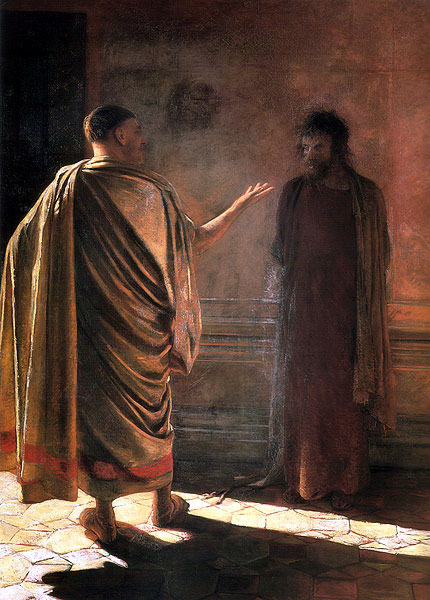is represented in table encounter between Christ and the Roman governor of Judea, Pontius Pilate. According to the Gospel, Pilate asked Christ: "What is truth?" To which Jesus responded with silence.
Contrast the figure of Pilate, wearing a toga, standing and illuminated by the sun, his gaze and gesture appear to disregard the meaning of the question. As a Christ Scruffy is confused in the shadows, his silence is his strength.
The free treatment of the Gospel texts Gue sometimes led to conflicts with religious and secular authorities. In 1892, by the governor of St. Petersburg, the painting was removed from an exhibition, being also forbidden to expose later in other Russian cities.
This work is part of the collection of the Tretyakov Gallery in Moscow. BIOGRAPHICAL LIST
. Nikolai
Gue was born in Voronezh in a family descended from a French nobleman migrated to Russia following the French Revolution. He studied at the Academy of Fine Arts in St. Petersburg. After she received a scholarship to travel abroad, visiting Germany, France and Italy.
In 1863 he returned to St. Petersburg with his painting "The Last Supper." Despite clear break with the academic canon success of the work was such that the Academy Gue appointed professor of history painting and portraiture. His next success was the play "Peter I interrogating his son Tsarevich Alexei in Peterhof" (1871) which featured the accuracy in the presentation of the situation, characters and setting. Since 1870 was a member and one of the organizers of the Travelers Group.
The last 15 years of his life was devoted entirely to biblical themes focused from the eternal struggle between good and evil where evil triumphs invariably the fate of these works was dramatic: it was banned and censored exposure by the Church. His latest book, "Golgotha" (1892), remained unfinished. The public could only Discovering after the painter's death. An amazing canvas surprising today surprised by its warm emotional and brave despair. BLOG HEADER
"The Last Supper."
PEDRO I, question your child the Tsarevich Alexei Peterhof - 1871
Opponents of the reforms of Tsar Peter included his own son Alexei, fruit from his first marriage, under the influence of the boyars rebelled against his father. Discovered the plot, the Tsarevich fled to Europe, via Vienna, Tyrol and finally washed up in the Castle of St. Elmo in Italy, where he was returned to Russia by order of his father. There, the Senate with the consent of the father Alexei sentenced to death, but died in the fortress of Peter and Paul before his execution.
truthfully To rebuild this historic event Nikolai Gue studied in depth documentation and portraits of the time playing with accuracy century costumes Century to the cabinet of the Emperor at Peterhof. In
Gue write his memoirs that during the creation of the table his sympathies were directed to the Czar Peter, but as was documented realized that this sympathy was not viable.
This work is part of the collection Tretiakov Gallery in Moscow.
"Golgotha" - 1892
All the attention in this book focuses on the suffering of Christ. The narrative elements are excluded and the image has acquired symbolic index finger accuser, the figure of Christ flanked by two thieves who take opposing expressions, one with a rictus of panic-stricken animal and one with a sad expression of meekness. Behind them chaos and formlessness.
The author seemed to show that the place the system for those seeking the truth was the gallows, among marginalized, madmen and criminals.
This work is part of the collection of the Russian Museum in St. Petersburg.
"Portrait of Leo Tolstoy" - 1984
A difficult period in the life of the painter Nikolai Gue preceded the realization of this picture. Eight years before this work decided to abandon painting and go live in a town which for years led a simple life farmer. He returned to art between 1870-1880 and this portrait was the first author's work in this later period.
painter Leo Tolstoy met shortly before the portrait and their friendship lasted until the death of Gue. It was very close to his family and came to teach painting classes to their daughters. This close contact helped him grasp the personality of Tolstoy. Gue said the same, the table wanted to reflect the most precious of his amazing personality. Public and critical
received the box with great perplexity. For starters were criticized that the model does not pose showing his eyes but appears to work as Tolstoy an ordinary artisan.
This work is part of the collection Tretiakov Gallery in Moscow.
CARRARA AT Taganrog.
"Tolstaya SOPHIA" (Wife of Leo Tolstoy.)
"CHRIST AND THE THIEF."
"CHRIST PRAYING IN GETHSEMANE." - 1888
Sources: Russian Museum and WIKIPEDIA. (Pictures and text and tables respectively.)








0 comments:
Post a Comment